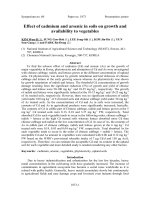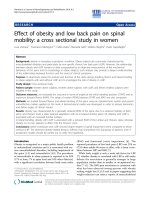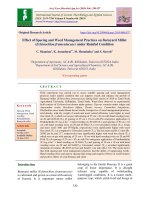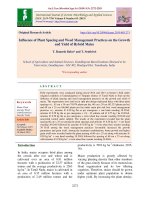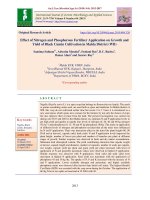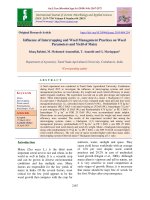Effect of spacing and weed management practices on Barnyard millet (Echinochloa frumentaceae) under rainfed condition
Bạn đang xem bản rút gọn của tài liệu. Xem và tải ngay bản đầy đủ của tài liệu tại đây (257.9 KB, 8 trang )
Int.J.Curr.Microbiol.App.Sci (2019) 8(6): 330-337
International Journal of Current Microbiology and Applied Sciences
ISSN: 2319-7706 Volume 8 Number 06 (2019)
Journal homepage:
Original Research Article
/>
Effect of Spacing and Weed Management Practices on Barnyard Millet
(Echinochloa frumentaceae) under Rainfed Condition
C. Shamina1, K. Annadurai1*, M. Hemalatha1 and S. Suresh2
1
Department of Agronomy, AC & RI, Killikulam, Tuticorin-6252824, India
2
Department of Soil Science and Agricultural Chemistry, AC & RI,
Killikulam, Tuticorin-628252, India
*Corresponding author
ABSTRACT
Keywords
Spacing, Weed
management, Hand
weeding,
Pendimethalin,
Barnyard millet
Article Info
Accepted:
04 May 2019
Available Online:
10 June 2019
Field experiment was carried out to assess suitable spacing and weed management
practices under rainfed condition that can suppress weeds and enhance the growth of
Barnyard millet (Echinochloa frumentaceae) during Rabi season of 2018 at Tamil Nadu
Agricultural University, Killikulam, Tamil Nadu. Weed flora observed in experimental
field consists of Echionocloacolonum under grasses, Cyperus rotundus under sedges and
Amaranthus viridis, Boerhavia diffusa, Cleome viscosa, Commelina bengalensis,
Phyllanthus niruri under Broad leaved weeds. Irrespective of weed management practices,
total density, total dry weight of weeds and weed control efficiency were higher in weed
free check (T11) which was on par with spacing of 25 cm x 10 cm with hand weeding twice
on 20 and 40 DAS (T 2) fb spacing of 25 cm x 10 cm with Pre emergence application of
Pendimethalin @1 kg ai ha-1 + hand weeding on 20 DAS (T 4) and spacing of 30 cm x 10
cm with hand weeding twice on 20 and 40 DAS (T 5) over unweeded control (T 12). Grain
and straw yield (1681 and 3975kg/ha, respectively) were significantly higher with weed
free check (T11) as compared to Unweeded control (T 12). The net return and B: C ratio (Rs.
26502 per ha and 2.17, respectively) were significantly higher with weed free check (T 11)
which was on par with spacing of 25 cm x 10 cm with hand weeding twice on 20 and 40
DAS (T2) fb spacing of 25 cm x 10 cm with Pre emergence application of Pendimethalin
@1 kg ai ha-1 + hand weeding on 20 DAS (T 4) and spacing of 30 cm x 10 cm with hand
weeding twice on 20 and 40 DAS(T 5). Unweeded control (T 12) recorded significantly
minimum net returns (Rs.6933 per ha) and benefit: cost ratio (Rs.1.34). The result shows
that both spacing and weed management practices had the ability of suppressing weeds.
Hand weeding twice and narrow spacing had strong and negative effects on weed biomass
and positive effects on crop biomass and yield.
belonging to the family Poaceae. It is a grain
crop of lesser importance. It is drought
tolerant crop capable of withstanding
waterlogged conditions. It is a fastest multipurpose crop, which yields food and forage in
Introduction
Barnyard millet (Echinochloa frumentaceae)
is cultivated and grown as cereal with nativity
of Eurasia. It is important minor millet
330
Int.J.Curr.Microbiol.App.Sci (2019) 8(6): 330-337
a short duration and at low inputs even under
adverse climatic conditions. In India, Japan
and China, Barnyard millet was often used as
a substitute for rice when the paddy crop fails.
In the U.S.A. it is grown primarily for forage,
and can produce up to eight harvests a year. It
does not require more irrigation. Barnyard
Millet is considered the least important of
cereals, with annual production less than 2%
of the world’s grain. It is found in most of the
southern and central states in India especially
wherever annual rainfall is below 350 mm,
whereas no other cereal crop can grow under
such moisture stress.
weeds infestation which was suppressed by
crops. It is a need of determining suitable
inter-row spacing for suppression of weeds
with effective weed management practices
either by herbicide application or manual or
mechanical weeding to increase the crop
yield, crop quality and reduce production
cost.
Materials and Methods
Field experiment was carried out during Rabi
season of 2018 at Tamil Nadu Agricultural
University, Killikulam, Tamil Nadu. The soil
of the experimental field was sandy clay loam
soil in texture with low in available organic
carbon (5.6 g/kg soil) and available nitrogen
(230 kg/ha) but medium in available
phosphorus (22 kg/ha) and potassium (256
kg/ha) with a pH of 7.8. The experiment
consisting of 12 treatments and were
factorially arranged and laid out in a
Randomized Complete Block Design with
three replications. The experiment was
conducted in randomized block design
replicated thrice with twelve different weed
management practices viz., broadcasting
(seeds of 10 kg ha-1) + Hand weeding twice
on 20 and 40 DAS (T1), spacing of 25 cm ×
10 cm + Hand weeding twice on 20 and 40
DAS (T2), spacing of 25 cm × 10 cm + one
Hand weeding twice on 20 + one Mechanical
weeding on 40 DAS (T3), spacing of 25 cm x
10 cm + PE Pendimethalin@ 1kg ai ha-1
followed by Hand weeding on 40 DAS (T4),
spacing of 30 cm × 10 cm + hand weeding
twice on 20 and 40 DAS (T5), spacing of 30
cm × 10 cm + one hand weeding twice on 20
+ one Mechanical weeding on 40 DAS (T6),
spacing of 30 cm × 10 cm + PE
Pendimethalin @ 1kg ai ha-1 followed by
hand weeding on 40 DAS (T7), spacing of 40
cm × 10 cm + hand weeding twice on 20 and
40 DAS (T8), spacing of 40 cm × 10 cm + one
hand weeding twice on 20 DAS + one
Mechanical weeding on 40 DAS (T9), spacing
Nutritionally, Barnyard millet is an important
crop. It is a rich source of protein (11.8%) and
crude fibre (9.8%). Out of the total protein; it
also consists of 16.6% of amino acid leucine,
which is twice the quantity of Rice, which is
highly digestible and is an excellent source of
dietary fibre with good amounts of soluble
and insoluble fractions. The grains of
barnyard millet are low in phytic acid and rich
in iron and calcium contents (Sampath et al.,
1990). The carbohydrate content is low and
slowly digestible, which makes the Barnyard
millet a natural designer food. In the present
days of increased diabetes mellitus, Barnyard
millet could become an ideal food.
In the year of 2014-2015, the total production
of minor millets in India is 6.83 lakh tonnes,
cultivated in area about 6 lakh hectares with
an average productivity of 630 kg ha-1. In
Tamil Nadu small millets are cultivated in an
area of 32000 ha with a production of about
35000 t. The average productivity of small
millets is about 1086 kg ha-1 (Agricultural
statistics at a Glance, 2015). Appropriate
inter-row spacing will help the crop to
compete with weed. Several reports indicated
that crops planted in narrow row spacing
suppress weed growth more than in wide row
spacing because high density of crop in
narrower inter row spacing resulting in lower
331
Int.J.Curr.Microbiol.App.Sci (2019) 8(6): 330-337
m-2, respectively) at 45 DAS which was on
par with spacing of 25 cm x 10 cm with hand
weeding twice on 20 and 40 DAS (T2) fb
spacing of 25 cm x 10 cm with Pre emergence
application of Pendimethalin @1 kg ai ha-1 +
hand weeding on 20 DAS (T4) and spacing of
30 cm x 10 cm + hand weeding twice on 20
and 40 DAS (T5). Among weed management
practices, weed free check (T11)had
significantly reduced dry weight of grasses,
sedges and broad leaved weeds(0.20 g m-2,
0.34g m-2and 0.59g m-2, respectively) at 45
days after sowing which was on par with
spacing of 25 cm x 10 cm with hand weeding
twice on 20 and 40 DAS (T2) fb spacing of 25
cm x 10 cm with Pre emergence application
of Pendimethalin @1 kg ai ha-1 + hand
weeding on 20 DAS (T4) as compared to
other treatments. Whereas, unweeded control
(T11) recorded significantly higher weed
population and weed dry weight, respectively.
The reduction in the weed population and
weed dry weight in these treatments was
mainly due to effective control of weeds at all
stages of crop growth period. These results
are in conformity with the findings of Sanjoy
Saha (2005) and Madhu Kumar et al., (2013).
However, the weed control efficiency
(98.18%) was also highest with weed free
check (T11) given in Table 1. This was mainly
due to better control of weeds right from
sowing to45 DAS, which is the critical period
for crop weed competition. These results are
in conformity with the findings of Pradhan et
al., (2010).
of 40 cm × 10 cm + PE Pendimethalin @ 1kg
ai ha-1 followed by hand weeding on 40 DAS
(T10),Weed-free
check(T11),
Unweeded
control (T12).
The variety used for the experiment was
MDU 1. A recommended dose of fertilizers
(40:20:0 N: P2O5: K2O kg/ha) was applied
equally to each plot. Nitrogen was applied in
two splits. Half dose of N (20 kg/ha) along
with full dose of P2O5 (20 kg/ha) were applied
as basal and remaining N (20 kg/ha) was
applied as top dressing after 30 days of
sowing. The source for nitrogen and
phosphorous were urea, di-ammonium
phosphate respectively. Weed counts (No.
m-2) and dry weight (g m-2) were recorded by
putting a quadrate (25 cm x 25 cm) at two
random spots in each plot at 45 DAS of the
crop. Weed control efficiency (WCE) was
also calculated on the basis of dry matter
production of weeds. The experimental data
recorded for growth, yield attributes and yield
were statistically analysed. Data on weed
density and dry weight of weeds were
transformed using square root transformation
(√X+0.5) before statistical analysis.
Results and Discussion
Effect on weeds
Weed flora observed in experimental field
were classified as Grasses, Sedges and Broad
leaved weeds. There were seven species
belonging to seven families. Weed flora
consists of Echionocloa colonum under
grasses, Cyperus rotundus under sedges and
Amaranthus viridis, Boerhavia diffusa,
Cleome viscosa, Commelina bengalensis,
Phyllanthus niruri under Broad leaved weeds
as reported by Gowda et al., (2012).
Effect on growth and yield attributes of
crop
All weed management practices significantly
improved the growth and yield attributes of
Barnyard millet over unweeded control (Table
2). Plant spacing plays an important role on
growth, development and yield of crops. In
general, yield of millets is greatly affected by
the plant population and higher yield could be
Weed free check (T11) significantly reduced
the density of grasses, sedge and broad leaved
weeds (0.43 No.m-2, 1.0 No.m-2 and 1.1No.
332
Int.J.Curr.Microbiol.App.Sci (2019) 8(6): 330-337
achieved with increasing plant population to a
greater extent. Barker (1996) reported that
when millet is grown in narrow spacing,
lower weed pressure and weed composition
was observed as compared to wider spacing.
Table.1 Effect of spacing and weed management practices on weed density, weed dry weight
and weed control efficiency at 45 DAS in barnyard millet under rainfed condition
Treatments
T1: Broadcasting 10 kg seeds
/ha+ 2 HW on 20 and 40 DAS
T2: Spacing of 25 cm x 10 cm + 2
HW on 20 and 40 DAS
T3: Spacing of 25 cm x 10 cm
+1 HW on 20 DAS + 1
Mechanical Weeding on 40
DAS
T4: Spacing of 25 cm x 10 cm +
PE Pendimethalin 1 Kg ai ha-1
fb 1 HW on 20 DAS
T5 : Spacing of 30 cm x 10 cm +2
HW on 20 and 40 DAS
T6: Spacing of 30 cm x 10 cm +1
HW on 20 DAS + 1 Mechanical
Weeding on 40 DAS
T7 : Spacing of 30 cm x 10 cm +
PE Pendimethalin 1 Kg ai ha-1
fb 1 HW on 20 DAS
T8: Spacing of 40 cm x 10 cm +2
HW on 20 and 40 DAS
T9: Spacing of 40 cm x 10 cm +1
HW on 20 DAS + 1 Mechanical
Weeding on 40 DAS
T10: Spacing of 40 cm x 10 cm +
PE Pendimethalin 1 Kg ai ha-1
fb 1 HW on 20 DAS
T11: Weed free check
T12: Unweeded control
SEd
CD(P=0.05)
Weed density
(No.m-2)
Grasses
Sedges
4.39(2.21)
1.27(1.33)
3.51 (2.00)
6.33
(2.72)
2.13
(1.62)
5.97
(2.54)
Broad
leaved
weeds
4.4 (2.21)
Weed dry matter production
(g m-2)
Grasses
Sedges
Broad
leaved
weeds
1.21
2.13
2.35
WCE(%)
89.43
2.1 (1.63)
0.43
0.70
1.42
96.08
4.4 (2.23)
1.36
2.01
2.37
90.20
2.97 (1.87)
5.53
(2.46)
3.2 (1.92)
1.16
1.76
1.75
91.74
3.10 (1.90)
5.40
(2.43)
6.80
(2.70)
3.2 (1.92)
1.19
1.75
1.76
91.88
3.7 (2.06)
1.68
2.24
2.06
89.85
4.30
(2.19)
6.77
(2.70)
4.5
(2.24)
1.65
2.29
2.43
89.08
4.42
(2.22)
5.11 (2.37)
7.93
(2.90)
6.97
(2.73)
3.8
(2.08)
3.3 (1.96)
1.85
2.57
2.18
88.66
2.13
2.93
1.79
89.15
4.03 (2.13)
7.27
(2.79)
4.6 (2.25)
1.57
2.78
2.42
88.87
0.43 (0.97)
1.00
(1.22)
71.60
(8.48)
0.09
0.19
1.1 (1.28)
0.20
0.34
0.59
98.18
36.4
(6.07)
0.09
0.19
13.92
23.2
20.9
0.00
0.25
0.53
0.24
0.50
0.21
0.44
3.88 (2.09)
34.91
(5.95)
0.03
0.07
Actual figures are transformed to X+0.5 and population figures are given in Parenthesis.
333
Int.J.Curr.Microbiol.App.Sci (2019) 8(6): 330-337
Table.2 Effect of spacing and weed management practices on growth and yield attributes of
barnyard millet under rainfed condition
Treatments
Plant height
LAI at 60 DAS
(cm) at harvest
Number of
Length of
productive
panicle(cm)
-2
tillers (m )
111.28
4.56
103.5
12.2
129.12
8.42
176
14.5
106.34
6.57
132
13.8
122.00
7.09
163
14.0
121.47
7.02
131
13.7
110.68
6.43
124
13.6
112.75
6.28
134
13.3
106.25
5.21
104
13.1
107.32
5.98
110
12.7
104.68
5.13
105
12.6
T11: Weed free check
129.69
8.53
176
14.6
T12: Unweeded control
96.73
3.52
97
11.8
SEd
0.76
5.32
0.08
CD(P=0.05)
1.59
11.04
0.17
T1: Broadcasting 10 kg seeds /ha+ 2 HW
on 20 and 40 DAS
T2: Spacing of 25 cm x 10 cm + 2 HW on
20 and 40 DAS
T3: Spacing of 25 cm x 10 cm +1 HW on
20 DAS + 1 Mechanical Weeding on 40
DAS
T4: Spacing of 25 cm x 10 cm + PE
Pendimethalin 1 kg ai ha-1 fb1 HW on 20
DAS
T5 : Spacing of 30 cm x 10 cm +2 HW on
20 and 40 DAS
T6: Spacing of 30 cm x 10 cm +1 HW on
20 DAS + 1 Mechanical Weeding on 40
DAS
T7
:
Spacing of 30 cm x 10 cm + PE
-1
Pendimethalin 1 Kg ai ha fb1 HW on 20
DAS
T8: Spacing of 40 cm x 10 cm +2 HW on
20 and 40 DAS
T9: Spacing of 40 cm x 10 cm +1 HW on
20 DAS + 1 Mechanical Weeding on 40
DAS
T10: Spacing of 40 cm x 10 cm + PE
-1
Pendimethalin 1 Kg ai ha fb1 HW on 20
DAS
0.16
0.36
334
Int.J.Curr.Microbiol.App.Sci (2019) 8(6): 330-337
Table.3 Effect of spacing and weed management practices on yield and economics of
barnyard millet under rainfed condition
Treatments
T1: Broadcasting 10 kg seeds /ha+ 2
HW on 20 and 40 DAS
T2: Spacing of 25 cm x 10 cm + 2
HW on 20 and 40 DAS
T3: Spacing of 25 cm x 10 cm +1 HW
on 20 DAS + 1 Mechanical Weeding
on 40 DAS
T4: Spacing of 25 cm x 10 cm + PE
Pendimethalin 1 Kg ai ha-1 fb 1 HW
on 20 DAS
T5 : Spacing of 30 cm x 10 cm +2
HW on 20 and 40 DAS
T6: Spacing of 30 cm x 10 cm +1 HW
on 20 DAS + 1 Mechanical Weeding
on 40 DAS
T7 : Spacing of 30 cm x 10 cm + PE
Pendimethalin 1 Kg ai ha-1 fb 1 HW
on 20 DAS
T8: Spacing of 40 cm x 10 cm +2 HW
on 20 and 40 DAS
T9: Spacing of 40 cm x 10 cm +1 HW
on 20 DAS + 1 Mechanical Weeding
on 40 DAS
T10: Spacing of 40 cm x 10 cm + PE
Pendimethalin 1 Kg ai ha-1 fb 1 HW
on 20 DAS
T11: Weed free check
T12: Unweeded control
SEd
CD(P=0.05)
Grain
yield(kg
ha-1)
1075
Stover
yield(kg
ha-1)
3049
1678
3944
22563
48834
26271
2.16
1096
3412
22658
36912
14254
1.63
1290
3594
22627
40914
18287
1.81
1289
3592
22563
40887
18324
1.81
1109
3443
22658
37293
14635
1.65
1179
3419
22627
38199
15572
1.69
1006
3337
22563
35112
12549
1.56
986
3095
22658
33405
10747
1.47
1010
3273
22627
34788
12161
1.54
1681
837
48.24
100.04
3975
2449
57.71
119.70
22563
20316
NA
-
49065
27249
NA
-
26502
6933
NA
-
2.17
1.34
NA
-
The highest values of plant height (129.69 cm
at 90 DAS), leaf area index (5.69 at 60 DAS),
number of productive tillers (176 m-2 at
maturity), length of panicle (14.6 cm at
maturity) were recorded under weed free
check (T11) which was on par with spacing of
25 cm x 10 cm with hand weeding twice on
20 and 40 DAS (T2) fb spacing of 25 cm x 10
Cost of
Gross
Net
cultivation return
return
(₹. ha-1) (₹. ha-1) (₹. ha-1)
22563
36579
14016
B:C
ratio
cm with Pre emergence application of
Pendimethalin @1 kg ai ha-1 + hand weeding
on 20 DAS (T4) and spacing of 30 cm x 10
cm + hand weeding twice on 20 and 40 DAS
(T5). The enhancement of crop growth and
yield attributes components could be due to
less competition by the weeds for crop these
factors throughout the crop growth period due
335
1.62
Int.J.Curr.Microbiol.App.Sci (2019) 8(6): 330-337
Pendimethalin @1 kg ai ha-1 + hand weeding
on 20 DAS(T4) (Table 3). This confirms the
finding of Khaliq et al., (2011). On the basis
of result obtained, it can be concluded that
hand weeding twice with narrow spacing of
25 cm × 10 cm (T2) found to be best as weed
management practice for better weed control
efficiency, crop growth, higher productivity
and profitability in line sown rainfed barnyard
millet.
to control of early emerged weeds before
sowing through pre-emergence application of
herbicides and late emerged weeds through
manual weeding. Similar results were
reported by Prashanth Kumar et al., (2015)
and Prithvi et al., (2015).
Effect on yield of crop
Data pertaining to Yield of Barnyard millet,
in which weed free check (T11) recorded
significantly higher grain and stover yield
(1681 kg/ha and 3975 kg/ha, respectively)
among different weed management practices
which was on par with spacing of 25 cm x 10
cm with hand weeding twice on 20 and 40
DAS (T2) as compared to unweeded control
(T12) (Table 3). The minimum grain and straw
yield in unweeded control could be due to the
severe weed competition as evidenced by the
maximum weed density, weed dry matter
which resulted in less number of tillers, lower
plant dry matter and plant height. Reduction
in grain yield of Barnyard millet was due to
weed competition was reported by Prashanth
Kumar et al., (2015) and Prithvi et al., (2015).
References
Agricultural Statistics at a Glance. 2015.
Directorate of Economics and
Statistics. Ministry of Agriculture,
Govt. of India, pp 73-74.
Barker, R.D., 1996. Millet production Guide.
A. 414.
Gowda,
S.G.K.,
Naveen,
D.V.,
Bhagyalakshmi, T. and Gowda, R.C.
2012. Weed management practices on
nutrient removal by weeds and its
relation to yield of finger millet in
eastern dry zone of Karnataka.
International Journal of Agricultural
Sciences. 8 (2):385-389
Khaliq, A., Riaz, M. Y. and Matloob, A.,
2011. Bio-economic assessment of
chemical and non-chemical weed
management strategies in dry seeded
fine rice (Oryza sativa L.) Journal of
Plant Breeding and Crop Science.
3(12): 302-310.
Madhu Kumar, V., Kalyana Murthy, K. N.,
Sanjay, M. T., Prashanth, R. and
Sunil, C. M. 2013. Growth and yield
attributes of aerobic rice as influenced
by application of pre and post
emergent herbicides. Plant Archives.
13(2): 771-774.
Pradhan, A., Rajput, A.S., and Thakur, A.
2010. Effect of weed management on
growth and yield of finger millet.
Indian Journal of Weed Science.
42(1&2): 53-56.
Effect on economics
A critical analysis of data on economics
revealed that the highest gross returns
(Rs.49065 ha-1) was obtained with weed free
check(T11). But higher cost of cultivation in
weed free check (Hand weeding twice) due to
engagement of more labourers for weeding.
This confirms the finding of Tuti et al.,
(2016).Spacing of 25 cm x 10 cm with Pre
emergence application of Pendimethalin @1
kg ai ha-1 + hand weeding on 20 DAS (T4)
compared to weed free check(T11). Maximum
net return (Rs.26502ha-1) and benefit: cost
ratio (2.17) were obtained with weed free
check (T11) which was on par with spacing of
25 cm x 10 cm with hand weeding twice on
20 and 40 DAS (T2)fb spacing of 25 cm x 10
cm with Pre emergence application of
336
Int.J.Curr.Microbiol.App.Sci (2019) 8(6): 330-337
Prashanth Kumar, M.K., Shekara, B.G.,
Yamuna, B.G. and Sunil, C.M. 2015.
Crop Weed Competition for Nutrients
by Weed and Drill Sown Finger millet
(Eleusinec oracana L. Gaertn.).
National Academy of Agriculture
Science. 33(3): 2049- 2054.
Prithvi, K.B., Rao, A.S. and Srinivasulu, K.
2015.
Weed
management
in
transplanted ragi. Indian Journal of
Weed Science. 47(2): 214–215.
Sanjoy Saha. 2005. Evaluation of some new
herbicide formulations alone or in
combination with hand weeding in
direct sown rainfed low land rice.
Indian Journal of Weed Science.
37(1&2): 103-104.
Tuti, M.D., Singh, S., Pandey, B.M., Bisht,
J.K. and Pattanayak, A. 2016. Weed
management in rainfed finger millet.
Indian Journal of Weed Science.
48(1): 74–75.
How to cite this article:
Shamina, C., K. Annadurai, M. Hemalatha and Suresh, S. 2019. Effect of Spacing and Weed
Management Practices on Barnyard Millet (Echinochloa frumentaceae) under Rainfed
Condition. Int.J.Curr.Microbiol.App.Sci. 8(06): 330-337.
doi: />
337

